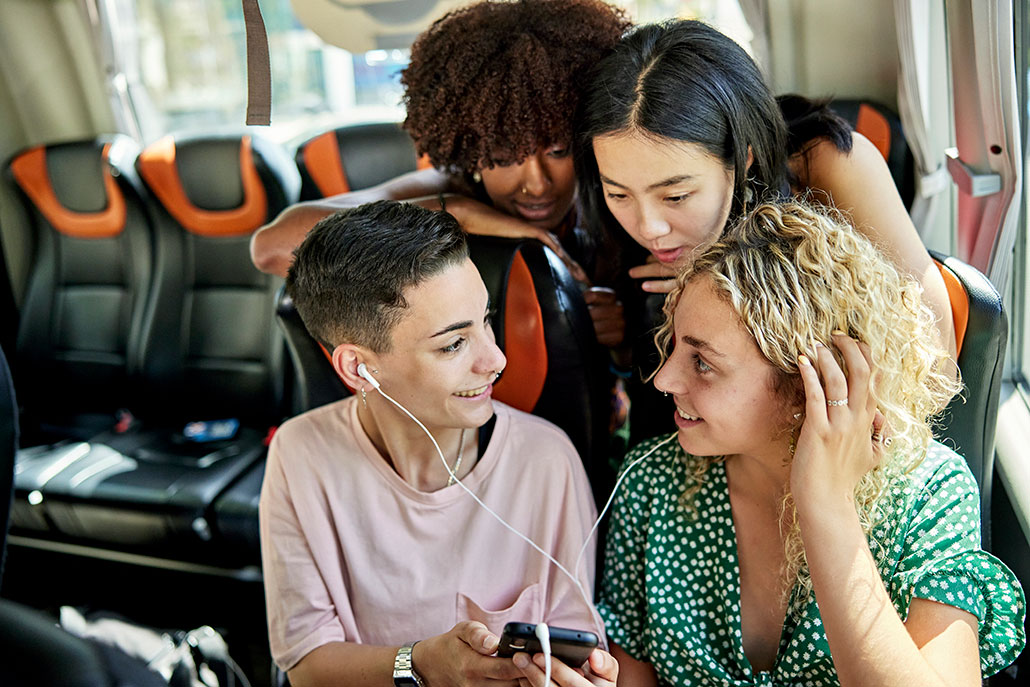Music has the power to move us physically and emotionally. Here’s why
The way music impacts the brain can improve mood and overall health

Music generates big emotional and physical benefits, which is one reason why social events — such as concerts — can help bring people together.
Flashpop/Digital Vision/Getty Images
Share this:
- Share via email (Opens in new window) Email
- Click to share on Facebook (Opens in new window) Facebook
- Click to share on X (Opens in new window) X
- Click to share on Pinterest (Opens in new window) Pinterest
- Click to share on Reddit (Opens in new window) Reddit
- Share to Google Classroom (Opens in new window) Google Classroom
- Click to print (Opens in new window) Print
Stop for a moment and listen to what’s going on around you. Do you hear the constant rhythm of a ticking clock? Or perhaps the vibrating bass of a truck’s engine? Now focus on what you can “hear” in your mind. Is there a song stuck in there, playing over and over on an endless loop? Maybe it’s just a few chords or the refrain from a popular song.
Music seems to be everywhere — even when it’s just in our own minds. It’s part of every culture around the world. Music brings people together, spreads ideas (hello, advertising jingles) and makes us move.
Researchers are investigating what music does to us and why — whether it’s making us tap a foot, evoking some strong emotion or urging us to get up and dance. They’re also studying the ways popular songs spread like a virus. They’re even looking at how our brains respond to music. And some are finding ways to put music to work helping people.

Can music be infectious?
Some songs tend to get stuck in our heads more easily than others. Or there’s something about them that makes us want to listen to them over and over. People often say such songs are “catchy.” When a song becomes super popular, we say it’s “gone viral.” Those words might be more accurate than we ever imagined, find researchers at McMaster University in Hamilton. That’s in Ontario, Canada.
David Earn is an applied mathematician. One day, he got to talking with musician and scientist Matt Woolhouse. Woolhouse had data on 1.4 billion songs downloaded to cell phones in 33 countries. “It was from the period when Nokia cell phones were being used to download music,” Earn explains. Some eight years ago, this was before most people had started streaming.
Woolhouse knew which songs had been downloaded. He also knew when they’d been downloaded and in which country the person was at the time.
And he found curious clusters of downloads. Some songs had been downloaded thousands of times over just a few weeks or months. Those patterns looked familiar to Earn. He studies disease epidemics. And those download data resembled the kind of data he saw with disease transmission.
“We wondered whether that kind of spread from person to person could be how people decide that they like particular songs,” Earn recalls.
Graduate student Dora Rosati took on the project. She had been working with a mathematical model. She used it to predict how diseases spread during an epidemic. The model compared three groups of people over time. One was susceptible to the disease; they’d never had it. A second group was currently infected with the illness. A third group was folks who’d had it but recovered. As an epidemic develops, people move from being susceptible into the infected group, then the recovered one. It’s such a consistent pattern, it can be described with math.
The team now used the same model with the song data. They looked at the 1,000 most downloaded songs in the United Kingdom, dividing them by genre. And these data, too, fit the disease model. For popular songs, downloads increased rapidly over time, much like a contagious disease infecting a group of susceptible people.

Some genres were more contagious than others, the team reported in 2021. “The group of people who connect and like folk music isn’t the same as the group of people who like heavy metal or dance music. They’re different social groups,” Earn says. “And some of those social groups are much more likely to share things quickly.”
Surprisingly, pop music wasn’t the most contagious. It spread, but not as quickly as some other genres. Electronica, on the other hand, was super contagious. Earn has a hypothesis about why. These listeners “are probably super connected on the web and sharing things” more than people who prefer other types of music.
“We think of contagion as a strictly negative thing,” Earn says. That’s especially true after living through the COVID-19 pandemic. “But that same process of contagion functions for other things in life,” he now concludes. Like sharing favorite songs with your closest friends.
Getting goosebumps
Sometimes you hear a song and just know it’s going to be a new favorite. Maybe you get goosebumps. Or you might feel your heart swell or a strong surge of happiness. That’s why you want to listen to it again — and why you’re likely to share it with others.
What causes such strong emotional responses? That’s a question Matthew Sachs has been studying. He works at Columbia University in New York City. As a cognitive neuroscientist there, he studies how people’s brains respond to different types of music.
People who take part in his research listen to music as they lie in an fMRI machine. All the while, the machine scans their brain. Sachs also asks the participants questions about how they feel while listening. Those scans hint that brain activity changes in response to the music.
Specific parts of the brain respond together in response to music, his studies reveal. “The brain is always active,” Sachs says. And there aren’t certain parts that respond only to music. But several networks, or linked groups of brain regions, become more active. Such functional networks are made up of “regions in the brain [that] tend to activate together and in sync,” he explains.
Some of these ramp up activity when tunes are playing. And they’re involved in lots of different things. The striatal (Stry-AY-tul) network processes emotions. One known as the default mode network allows us to daydream. The motor network lets us move. And the auditory network, of course, responds to sounds.
Some parts of the auditory network are also closely tied to emotions and empathy.

In 2020, researchers studied people’s brains as they listened to what we might call “sad” music. Although the music was created to evoke sad feelings, many people reported that they enjoyed listening to it. “There’s a whole theory of emotions that we have to be able to recognize [an emotion in a song] in order to feel it,” Sachs says. But the two can become disconnected, especially when listening to music or reading a story.
“Many people have these experiences where they can recognize that something is trying to make them feel sad,” Sachs says. “But they don’t necessarily feel sad.” The opposite can also be true. The song “Happy Birthday” is “probably supposed to make people feel happy.” But Sachs points out that many people may not feel happy when they hear it.
People can also feel sadness and enjoy it, he’s found. “Sad music can be pleasurable.” That’s somewhat unexpected, he notes, as sadness “is something we typically don’t enjoy.” But it can help us experience emotions that allow us to feel deeply. It might even purge other negative emotions that we felt before we started listening.
Through his research, Sachs has identified brain networks that seem to play a role in changing emotions. Going from happy to sad, for example, or anxious to happy. He hopes the finding will lead to future treatments for people who get stuck in one emotion, as can happen with depression.
Music as therapy
Highly emotional music causes networks in the brain to release dopamine. This brain chemical, a type of neurotransmitter, plays a role in feelings of pleasure. It also turns on the brain’s motor network. And that makes us want to move, explains Olivia Brancatisano. She is a stroke and aging researcher at Monash University in Melbourne, Australia.
Whether it’s tapping a foot or getting your groove on, movement can be beneficial. Music “can boost our willingness to engage in physical activity, ultimately benefiting our well-being,” she says.
That physical response to a rhythmic beat can be used to help people with brain-related disorders, research has shown. It aids their ability to time their body’s movements. That can help them with speech issues or trouble moving around.
As a graduate student, Brancatisano worked with William Forde Thompson. A psychologist at Bond University in Robina, Australia, he studies music and aging. The pair found that music can offer a number of benefits, from movement and emotion to communication and thinking. That led them to suspect music-based therapies might aid people who struggle in these areas.
Older people who have had a stroke or have dementia may struggle to speak or remember things. But they did better on mental tasks while listening to music they knew and enjoyed.
The selected music had to be highly emotional and personal, Brancatisano notes. Listening brought back memories and improved their attention. The two researchers have since developed the Music Mind and Movement program for people with dementia. It uses music-based activities to boost memory and thinking.

Music helps young people, too. One 2020 study in Israel looked at kids with attention-deficit/hyperactivity disorder, or ADHD. The research showed that these kids focus on a task better when music plays in the background. It didn’t matter if the music involved singing, as long as the song was calming overall. Danceable beats didn’t boost their focus. And kids without ADHD got no benefit from any type of background music. Instead, they found it distracting.
People of all ages can use music to improve their moods. When someone is feeling down, listening to music they enjoy can help pull them out of their funk.
International students in Australia took part in a recent study at the University of Queensland in St. Lucia. Students may often feel lonely or isolated while far from home. Those in the Tuned In program, however, learned to better manage their anxiety using music. They also got better at identifying their emotions. That helped them take action when they were struggling. Breathing exercises helped them manage anxiety. And mood-boosting music improved their emotions when they felt down.

The benefits of music seem to span people of all ages and cultures. “We use it to meet basic human needs and to tweak our emotional states,” says Thompson at Bond University. And those benefits can come from all different types of music. In fact, people may experience completely different emotions when listening to the same song.
For example, people who aren’t fans of death metal classify it as “angry and violent,” Thompson notes. Fans of the genre, however, experience a very different reaction. To them, its energy “is empowering and joyous,” he says. They even consider the songs peaceful.
“Now, more than ever, we have the ability to engage in music in a multitude of ways,” Brancatisano says. We can use it “as a tool in everyday life to motivate and energize us or soothe and comfort us. The great thing about music is that it can do both!”







